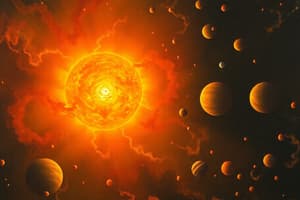Podcast
Questions and Answers
Pluto dikategorikan sebagai planet kerdil berdasarkan definisi yang direvisi oleh?
Pluto dikategorikan sebagai planet kerdil berdasarkan definisi yang direvisi oleh?
Manakah dari pernyataan berikut yang tidak benar tentang Pluto?
Manakah dari pernyataan berikut yang tidak benar tentang Pluto?
Planet manakah yang dikelilingi oleh cincin yang sangat indah?
Planet manakah yang dikelilingi oleh cincin yang sangat indah?
Berapakah jumlah planet gas raksasa yang ada di tata surya kita?
Berapakah jumlah planet gas raksasa yang ada di tata surya kita?
Signup and view all the answers
Apakah yang dimaksud dengan 'retinues of satellites' dalam teks tersebut?
Apakah yang dimaksud dengan 'retinues of satellites' dalam teks tersebut?
Signup and view all the answers
Apa yang disebut sebagai 'virtual ocean world' dalam teks tersebut?
Apa yang disebut sebagai 'virtual ocean world' dalam teks tersebut?
Signup and view all the answers
Apa yang menyebabkan pembentukan awal dari planet-planet dalam sistem tata surya?
Apa yang menyebabkan pembentukan awal dari planet-planet dalam sistem tata surya?
Signup and view all the answers
Apa yang mendominasi planet-planer di sekitar area dekat Matahari?
Apa yang mendominasi planet-planer di sekitar area dekat Matahari?
Signup and view all the answers
Planet-planet seperti Jupiter, Saturnus, Uranus, dan Neptunus disebut planet apa?
Planet-planet seperti Jupiter, Saturnus, Uranus, dan Neptunus disebut planet apa?
Signup and view all the answers
Apa yang dimaksud dengan planet-planet Terestrial?
Apa yang dimaksud dengan planet-planet Terestrial?
Signup and view all the answers
Apa yang menjadi sumber tekanan internal utama bagi planet-planet raksasa seperti Jupiter?
Apa yang menjadi sumber tekanan internal utama bagi planet-planet raksasa seperti Jupiter?
Signup and view all the answers
Apa komponen utama yang membentuk awal dari keluarga tata surya?
Apa komponen utama yang membentuk awal dari keluarga tata surya?
Signup and view all the answers
Study Notes
Discovering Our Cosmic Neighborhood: An Introduction to Planets within our Solar System
For millennia, humans marveled at celestial phenomena above, unaware of the complex dance of celestial bodies revealed through modern eyes. The solar system, home to our beloved Earth, consists of the Sun, eight planets, numerous moons, countless asteroids, and an assorted cast of comets and dwarf planets. Let's delve into the fascinating realm of planets, starting with their origins and characteristics.
Formation and Evolution of the Solar System
Approximately 4.5 billion years ago, our corner of the galaxy gave birth to our solar family. A colossal cloud of gas and dust contracted under its own weight, forming a disc surrounding our now radiant Sun. Driven by gravity, dust grains enthusiastically collided, combining into progressively larger entities. As temperatures rose closer to the Sun, rocks and metallic compounds dominated the inner planets. Further away, volatile molecules prevailed, leading to the emergence of Jupiter, Saturn, Uranus, and Neptune — gas giants centralized around their own internal pressure sources rather than solid surfaces.
Types of Planets
Planets are categorized according to their composition and distance from the Sun. The innermost four are referred to as Terrestrials, consisting of Mercury, Venus, Earth, and Mars. These solid, rocky bodies are situated near the Sun's heat source. Beyond Mars, the vast expanse of the Main Asteroid Belt occupies a void before reaching the denizens of the Gas Giants, namely Jupiter and Saturn, each surrounded by stunningly beautiful rings and complex moons. Lastly, residing outside of Saturn lay the Ice Giant twins, Uranus and Neptune, accompanied by their respective retinues of satellites.
The Eighth Planet: Demotion and Redefinition
Pluto, once regarded as our solar system's ninth planet, was demoted to dwarf status owing to the International Astronomical Union's revised definition of a planet. However, the icy world maintains a loyal following as it shares traits characteristic of planets as defined traditionally. To accommodate its unique nature, Pluto serves as the prototype member of the newly established category of dwarfs.
Moons in Abundance
Moons vary widely in number, size, location, and purpose. From the barren landscapes of Mercury and Venus to the lunar harbor of Mars and virtual ocean world of Saturn's moon Titan, every planet bears witness to its own complement of satellite(s).
From its humble beginnings amidst a sea of stars to the vibrant tapestry of celestial bodies existing today, our solar system remains a testament to the grandeur, wonder, and relentlessness of Nature.
Studying That Suits You
Use AI to generate personalized quizzes and flashcards to suit your learning preferences.
Description
Explore the formation, evolution, types, and characteristics of planets within our solar system. Learn about the demotion and redefinition of Pluto and the abundance of moons accompanying each planet in our cosmic neighborhood.




